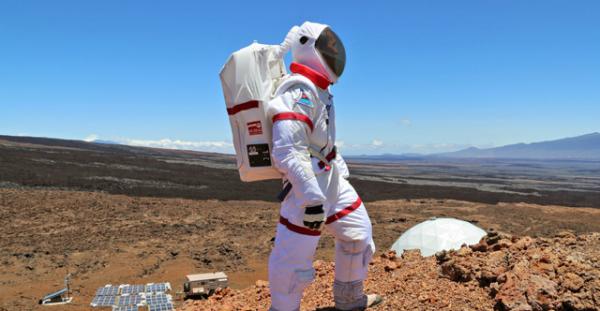KID REPORTERS’ NOTEBOOK
A Planet Close to Home?


A researcher at NASA’s simulated Mars habitat on the Big Island of Hawaii. Adapting to relative isolation is one of the challenges of the mission.
Everyone knows that Hawaii is millions of miles from the planet Mars. But it turns out that Hawaii and Mars have a special bond. The National Aeronautics and Space Administration (NASA) is currently carrying out a Mars simulation on the Big Island of Hawaii. The simulation, which began in October 2014, is expected to last until June.
Six scientists, who are members of NASA’s Hawaii Space Exploration Analog and Simulation (HI-SEAS) team, are currently “onboard the mission.” They live in a two-story dome on the northern slope of the Mauna Loa volcano, where the rocks, the color of the dirt, and the relative isolation make this an ideal place for a Mars simulation.
LIVING IN CLOSE QUARTERS
During the mission, several experiments are being conducted. For example, crew members are determining how a 3-D printer might benefit a future mission to Mars by printing out useful parts.
The mission is also studying the cognitive (mental) and emotional effects of long-term space travel.
“We are collecting a lot of psychology data,” Martha Lenio, commander of the mission, said via email. “They have us fill out surveys about how we feel and who we’re interacting with at different points throughout the day. We write journal entries and play team games. What NASA is trying to find out is how to pick a crew that can live together in close quarters for three years and be able to perform at a high level, autonomously, in remote circumstances.”
BUILDING TEAMWORK
Simulations allow crew members to cultivate a variety of skills. “It’s been a great opportunity in leading a team on a long-duration mission, with tasks and objectives that we have to meet,” Lenio observed. “I think my leadership skills are improving as the mission continues.”
Several other simulations are happening around the world, including at the Concordia Research Station in Antarctica, the Flashline Mars Arctic Research Station in Nunavut, Canada, the Mars Desert Research Station in Utah, and the NASA Extreme Environment Mission Operations (NEEMO), an undersea research station. The simulations will be invaluable for future missions to Mars.
